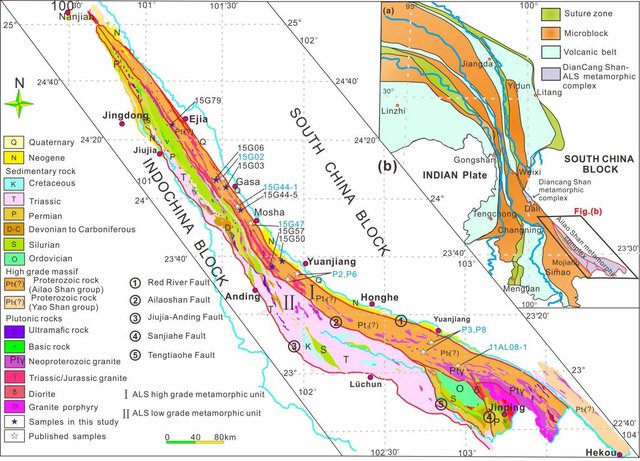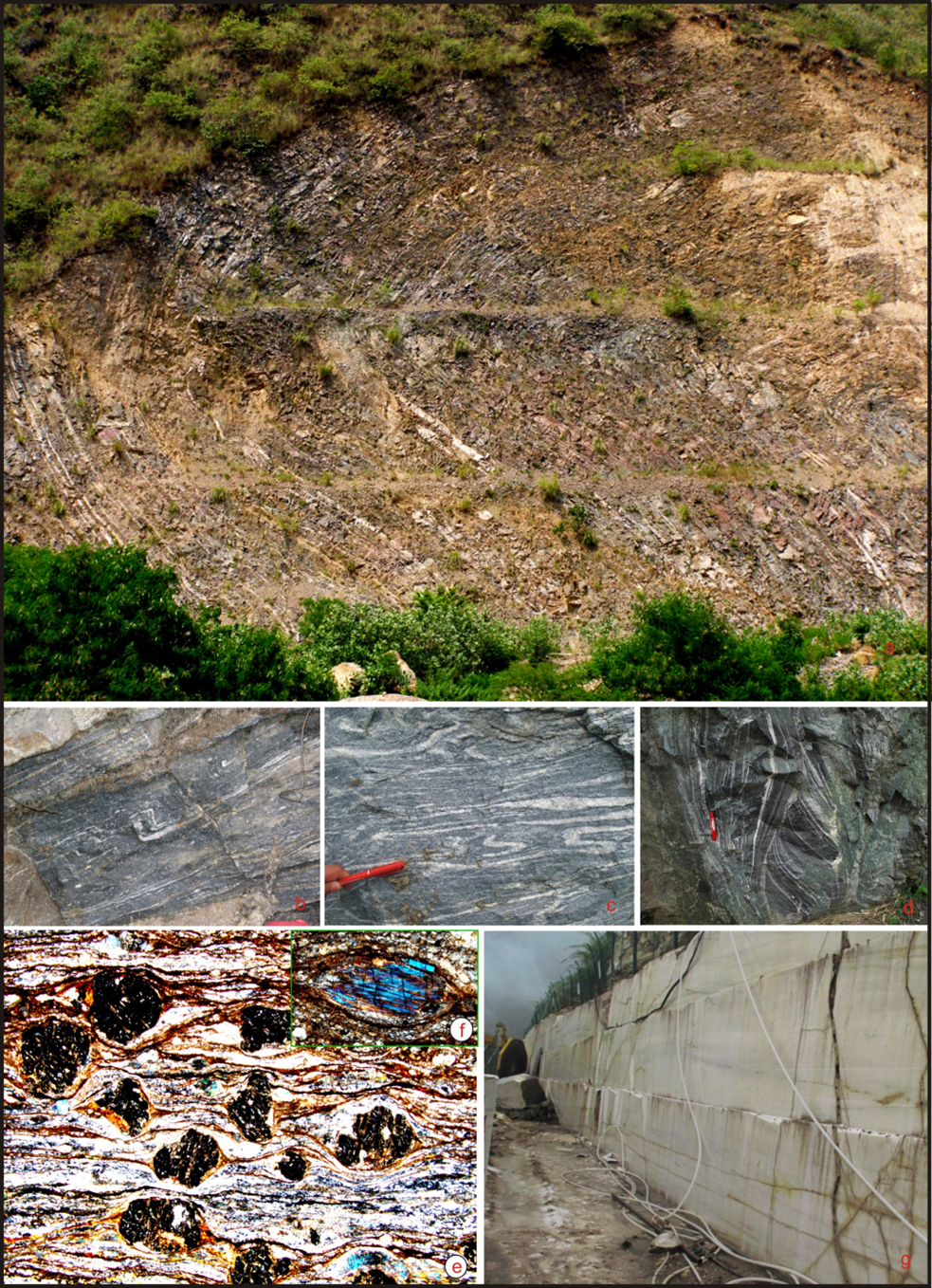Ailaoshan Gr
Type Locality and Naming
Dali region, northern West Yunnan. The Ailaoshan Group was named by the Regional Geological Survey Party of Yunnan Geological Bureau in 1965. It was subdivided into four formations: Xiaoyangjie Fm, Along Fm, Fenggang Fm and Wudukeng Fm, in ascending order. The nominative section of the Xiaoyangjie Fm is located in Nanmanhe of Xiaoyangjie, Yuanjiang County, Yunnan Province; the one of the Fenggang Fm and Along Fm is at Dawenmihe of Yuanjiang County; and the one of the Wudukeng Fm is in Dapingtai along the Gejiu-Jinping highway.
Synonyms: (哀牢山群) , Ailao Shan Group
[Figure: "Tectonic sketch map of Sanjiang tectonic zone and Ailao Shan metamorphic complex, southwestern China" (from Ji, L., et al., 2019, Acta Geol. Sinica)]
Lithology and Thickness
The Ailaoshan Gr shows a belt-like distribution with NW-SE trend along the Ailaoshan, its boundaries have been demarcated by Ailaoshan fault (the southern segment of the Jinsha River-Ailaoshan fault) and Honghe fault from eastern and western flanks respectively. It is a progressively metamorphic zone from high greenschist facies to low amphibolite facies, of which the low amphibolite facies are predominant in distribution. Its protoliths were composed of intermediate-basic to basic volcanic flyschoid type of volcanic-sedimentary rocks (Dong Shenbao et al., 1986). It is subdivided unsuitably into four formations.
The Xiaoyangjie Fm (小羊街组) is the lower part of the Ailaoshan Gr, which is mainly composed of biotite plagioclase gneiss, intercalated with thin layers of amphibolite, hornblende (diopside) leptite, biotite schist, associated with homogeneous migmatite; the middle part, biotite leptite, biotite plagioclase gneiss, bi-mica quartz schist; the upper part, andalusite plagioclase bi-mica schist, garnet andalusite bi-mica schist. The total thickness of this formation is more than 1294 m.
The Along Fm (阿龙组) is subdivided into two subformations: the lower part of the Lower subformation consists of graphite-bearing tourmaline biotite plagioclase leptite, garnet biotite plagioclase gneiss, leptite, with intercalations of sillimanite biotite gneiss and biotite plagioclase scapolite-diopsidite; the middle part, sillimanite biotite bi-feldspar gneiss, biotite plagioclase gneiss, amphibolite, intercalated with biotite K-feldspar diopsidite, K-feldspar scapolite diopsidite; the upper part, garnet hornblende plagioclase gneiss, amphibolite. The Upper subformation is predominately composed of marble, with intercalations of thin-bedded amphibolite, diopside hornblende plagioclase leptite. The total thickness of this formation is over 1788 m.
The Fenggang Fm (凤港组) is composed of sillimanite biotite bi-feldspar gneiss, sillimanite biotite plagioclase gneiss, leptites, intercalated with garnet hornblendite, hornblende plagioclase leptite, K-feldspar biotite diopsidite with migmatitic granite; the middle part, amphibolite, biotite-bearing diopsidite; the upper part, sillimanite biotite bi-feldspar gneiss, leptite, amphibolite, garnet amphibolite and migmatitic granite; the top consists of marble intercalated with banded amphibolite. The total thickness of this formation is about 1419 m.
The Wudukeng Fm (乌都坑组) is the upper part of the Ailaoshan Gr and can be subdivided into six lithomembers. The lower four members consist mainly of biotite hornblende plagioclase gneiss, and secondarily of biotite plagioclase gneiss, leptite, (diopside) amphibolite, marble etc., with migmatization. The upper two members consist of augen-like biotite migmatite, garnet biotite plagioclase leptite, migmatized sillimanite biotite quartz schist, plagioclase muscovite schist, graphite schist and quartz schist. The total thickness of this formation is over 2264 m.
[Figure: The Ailaoshan Gr in Yunnan Province (photos by Qi Yuanqiang). a-Fold structures; b-c-d-Deformation structures in field section; e-f-Deformation structures in thin sections; g-Diopside marble in deep metamorphic rock zone.]
Relationships and Distribution
Lower contact
Unconformable onto the underlying Damenglong Gr (Mesoproterozoic underlying all of West Yunnan)
Upper contact
This group is connected with both contiguous Lower Paleozoic and Mesozoic strata by faults.
Regional extent
The exposed area is about 3800 square kilometers. " The ALS belt in the southeastern Tibetan Plateau is separated from the SCB by the Red River fault inthe east and from the Indochina Block by the Anding-Jiujia fault in the west, and this NW-SE-trendingbelt is over 500 km long and 10 to 50 km wide" (Ji, L., et al., 2019, Acta Geol. Sinica; see figure). It extends northward to the vicinity of Midi in Nanjian County, disappearing at the intersection of the above two faults, and southward into Viet Nam. Yunnan Bureau of Geology and Mineral Resources (1990) suggests that the Yaoshan Gr distributed in the vicinity of Gama-Hekou Town in Hekou County and the region of Lüshuihe, Mengzi County, is tightly close to the Ailaoshan Group and is roughly equivalent to the Xiaoyangjie Fm and Along Fm of Ailaoshan Gr. The Cangshan Fm (Cangshan Gr) of upper Sinian that is distributed in the area of Diancang mountains-Luopingshan of Dali City, Yunnan Province, is possibly equivalent to the Along Fm of the Ailaoshan Gr. The succeeding tectonism separated them.
GeoJSON
Fossils
Age
Depositional setting
Its protoliths were composed of intermediate-basic to basic volcanic flyschoid type of volcanic-sedimentary rocks (Dong Shenbao et al., 1986).
Additional Information
The sedimentary-metamorphic type of copper-mineralization has been discovered over ten places in this metamorphosed sequence, and large-scale sedimentary metamorphic-type copper deposit has been found in the same geological settings in the neighboring country of Viet Nam. Rutile, emerald, aquamarine, topaz etc. occur in some pegmatites intruded into the Ailaoshan Gr during the Himalayan orogenic period; and the place where these middle-rank gems occur is one of the two great gem-pegmatite zones (Sun Kexiang, 1993).

